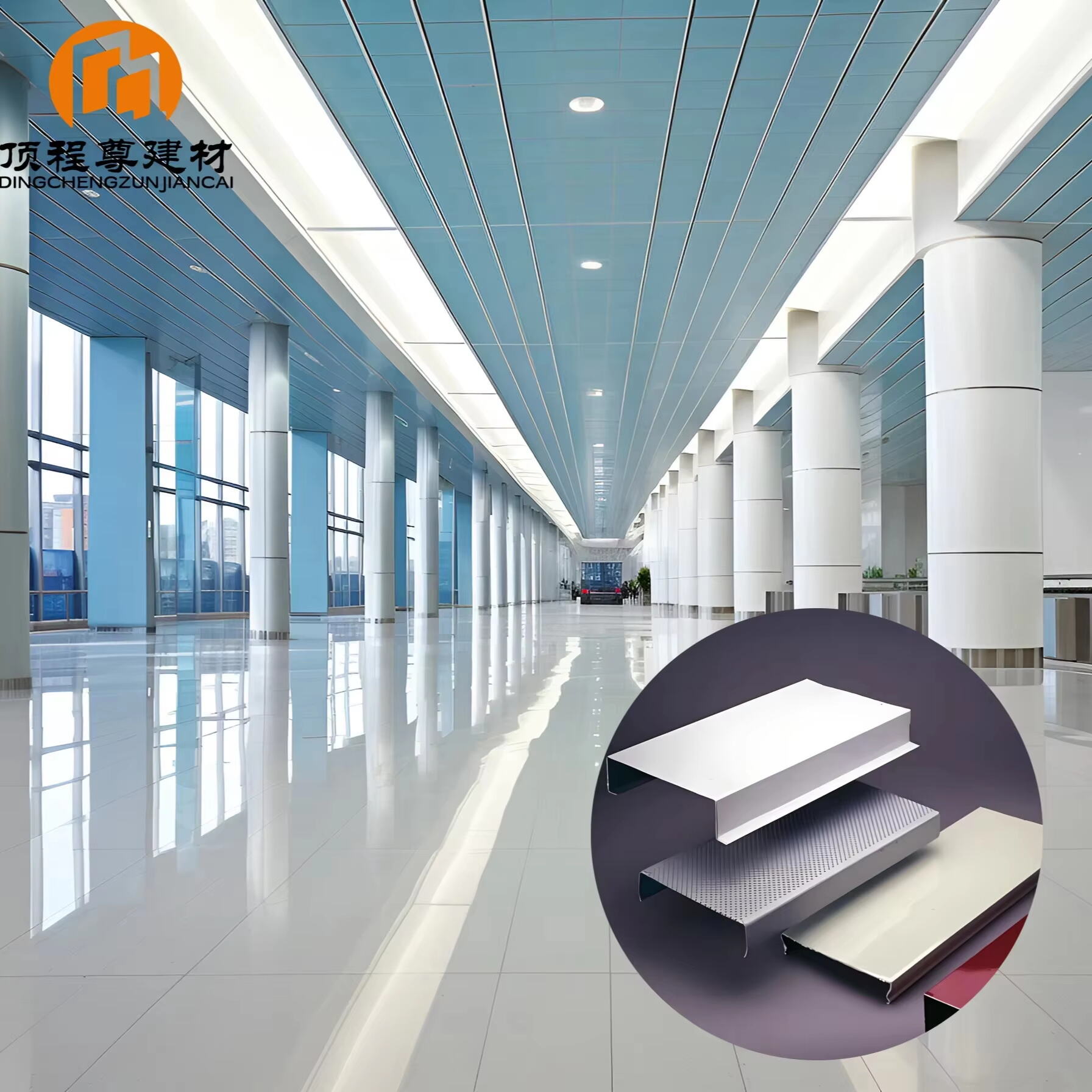The Rising Trend of Strip Ceilings in Contemporary Design
Defining Modern Architectural Priorities
The contemporary architecture has now shifted focus to casual open spaces and cleaner undertones. This not only makes the space attractive, it also optimizes the effective use of space which in the cities of today is important. Strip ceilings, known for their smooth lines and understated designs, fit right in with this architectural importance. Their simplicity of form makes them also ideal for minimalist or decluttered styles too.
Architectural designers themselves advocate flexibility in contemporary spaces, which helps explain the growing popularity of strip ceilings. As structural engineer Bill Baker, famously said "new demands must be met with new architecture." These constructional innovations allow open space options and customization, giving rise to the increased demand on modern design projects.
Strip Ceilings as a Symbol of Progressive Design
Ornamentation of ceilings has gone in and out of style throughout the course of history with ornamented ceilings being the fashion in the late 19th & early 20th centuries. This shift represents an increased open-mindedness toward progressive design, at the intersection of form and function. Strip Ceilings are the logical expression of this new generation of “green” architects and designers. Constructed out of materials such as aluminum, they are durable and energy efficient, which is in line with current environmental concerns.
The demand of strip ceilings in commercial and residential premises is also increasing due to its innovative role in modern architecture. This seems to be supported by statistics- the figures show a surge of 30% in the use of strip ceilings over five years. This surge highlights how they serve contemporary architectural needs, which are leaning towards an intelligent combination of originality, functionality, and eco-sustainability.
Sleek Aesthetics: Elevating Minimalist Spaces
Clean Lines and Visual Continuity
The aesthetic of clean lines in modern backgrounds has its visual consequences and it is here that strip ceilings have a role to play. They help to visually unify, appearing to become a part of various areas in a space. Efforts, such as the upgrade of old office space to sophisticated,contemporary work areas, have drawn strip ceilings in the limelight of image harmony. A natural beauty, their steadfast design and natural beauty is focused on the way the systems work – not the way it looks.
Seamless Integration with Minimalist Interiors
The vast majority are manufactured to complement contemporary minimalistic styles, adding style to any room with their unobtrusive colours and simple textures. They bring the calm, clean vibe of a minimalist space to it too. Research indicates minimalist spaces can lift our mood and provide a positive impact on productivity through minimizing visual clutter, allowing us to focus on the task at hand. In spaces of focus and tranquility such as the office or home, with a focus on functional minimalism, strip ceilings perfectly sum up the clean lines of other interior finishes to provide an integrated appearance.
Versatile Lighting Solutions for Dynamic Environments
Customizable LED Integration
Tailored LED integration in strip ceilings is an innovative approach that contributes to the increase of both flexibility and energy efficiency. Soft and soothing Dasal ensures the necessary amount of light in your rooms, wherever you're in need of functional light? even in multiple locations in your room? is impossible with normal lighting. It has been demonstrated that projects with strip ceilings, which include LEDs, can lift and renovate spaces, creating a new ambience that is both well designed and purposeful. The case studies show that LED's energy efficiency is an essential element in sustainable building design in terms of lowering electricity costs with the provision of high aesthetics as well.
Mood Enhancement Through Layered Illumination
Layered lighting is a mood booster, offering myriad moods within a single space. One advantage of this embodiment is that various layers of light can be varied to the user’s preference with a convenience accommodating transition between settings for differing activities or occasions. Currently, the layer approach is being continuously refined with new lighting design techniques, especially via light lines in ceilings, which are based both on advanced technical and high esthetic light planning and design. These are not only user-experience enhancers, but also guaranteeing a simple adaptation to varied requirements in spaces. In order to optimize these benefits, consideration needs to be given to how lighting system strip ceilings can impact upon the way users interact with spaces.
Space Optimization Through Strategic Design
Creating Vertical Illusions of Height
Clever games also in strip ceilings We can make rooms appear great vertically. Trompe l'oeil tricks, like painted vertical line patterns and shiny surfaces, can make you believe that your bathroom's ceiling is at a greater height; while they really won't affect the structure at all, they do make the room seem bigger than it is. There are techniques applied by architects and designers, as demonstrated by studies which are similar to the maximisation of spatial perception in interior design. For example, materials that reflect the light and the use of a light color palette make the ceilings seem taller, this technique will open up the spaces in homes and commercial settings.
Multifunctional Design for Compact Layouts
Strip ceilings can be used to complement multiple design features in smaller spaces. They are versatile and that enable to integrate the utilities like, lighting,sound and ventilation into single unit to minimize the number of loose objects and increase its usability. In successful interior designs strip ceilings are used to harmonize functions and aesthetic requirements while converting underutilized space into effective design solutions. Examples are smaller apartments or offices for which these ceilings not only serve a decorative purpose but also offer a space optimizing way of enlivening—in other words structuring or dividing and reclaiming the space by concealing essential installations; cleaner, more complex and sophisticated.
Tech Integration for Smart Architectural Systems
IoT Compatibility in Modern Ceiling Systems
Nowadays, strip ceilings are becoming more and more central in IoT-based devices integration in the context of modern architectural design. These ceilings are a perfect fit for the integration of sensors and smart gadgets into architectural systems without sacrificing aesthetic beauty. Their open and flexible design allows an integration of lighting, climate control, and security systems, a characteristic that fits well with future smart building technologies. Developers are forecasting future trends in which the ceiling will not just facilitate IOT infrastructure but actually help to generate dynamic, responsive spaces. For example, with integrated air quality monitors and adaptive lighting systems, ceilings can make contribution to sustainable living spaces by conserving energy and improving occupants comfort.
Automated Lighting Controls and Energy Management
This is one of the reasons why automatic lighting management in combination with strip ceilings is so important. By incorporating intelligent lighting systems which respond to natural daylight contributions and occupancy levels, energy usage can be significantly reduced. Statistics indicate that a well-used automatic light control can save up to 30% in energy usage, clearly demonstrating this method to be effective when it comes to power consumption. These systems can be setup to match the lighting levels and colours to an interior preference, as well as being configured for the most energy efficient set-up. As a result, ‘this integration makes sure that the spaces look good and are smart and sustainable,’ adds the company statement.
FAQ
What are strip ceilings?
Strip ceilings are ceiling systems that consist of long, narrow panels typically made from materials like aluminum. They are known for their sleek lines and unobtrusive profiles, making them popular in modern architectural design.
Why are strip ceilings popular in contemporary design?
Strip ceilings are popular in contemporary design due to their clean aesthetics, flexibility, and ability to seamlessly integrate with minimalist styles. They offer functional benefits such as customizable lighting and integration with smart building technologies.
How do strip ceilings contribute to energy efficiency?
Strip ceilings facilitate energy efficiency through features such as customizable LED lighting and the ability to integrate automated controls. This can reduce energy consumption and lower electricity costs while maintaining desired lighting and aesthetic standards.
Can strip ceilings be used in residential spaces?
Yes, strip ceilings are suitable for residential spaces. They enhance minimalist designs and can support smart home integrations, providing both aesthetic appeal and functional advantages in homes.


